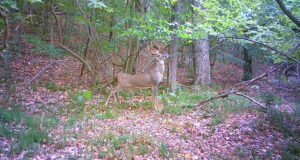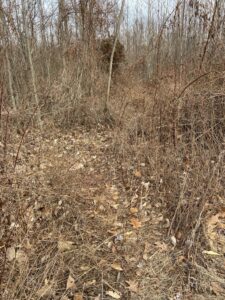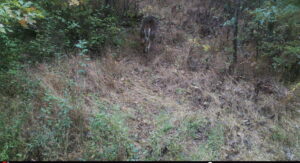Part 2
In Part One of our “Identifying a Property’s Strengths and Weaknesses” series, I shared the beginning of Neil Dougherty’s considerations for examining and assessing a property. Today’s blog post is Part Two of this conversation and will begin to outline more specifics of the foundational elements of land management.
Foundations of a Property
Good deer properties are created by quality soil. The idea is, if you have good dirt you can grow good deer and quality plants/food. The common thought used to be that the great nutrient rich midwestern soil, in Iowa for example, transfers all the minerals and nutrients to the deer through the plants the deer consume. It was widely believed this nutrient transfer was responsible for creating big deer and big antlers. If this were the case, taking those same Iowa deer and transplanting them here in Pennsylvania would result in a sharp decline in antler mass. Recent studies have disproven this common misconception. A research group in Tennessee selected a variety of plants from across the country and found that a natural edible in Pennsylvania (or anywhere else for that matter) had the same protein and mineral content as a natural edible in Iowa. The difference is not the nutritional content of the plants, but the ability of the soil to produce more food per acer in these fertile soil states. An acre in Iowa might produce 1,800 pounds of natural food, whereas an acre may only produce 800 pounds of food in Pennsylvania or other state. So what does all this mean? Push the native plants and food to the deer and you can start to see your bucks begin to reach their genetic potential. In most cases, land managers don’t have a mineral/soil issue, but simply a property that is not producing enough food. Deer are primarily eating brambles, briars, and various forms of brush. Without listing out all 200 species of natural edibles, it’s safe to say if the plant produces a flower… at some point deer will eat it. If the food is at a deer’s level, they’ll nip it off. Deer get two-thirds of their nutrients from the last (or most recent) 1 inch of plant growth which is is where all the digestible nutrients are. While turkey hunting this spring, take inventory of the browse and how hard the deer have hit it this year—young ash trees, young oak trees, young maple trees, and green briars etc. If your browser is decimated, you have a food issue. If the browse has been used but not wiped out, your food levels are likely adequate for the number of deer in your area. Everyone wants to look out into a food plot and see deer, but the natural browse is where you grow quality bucks.
Determining Habitat Food Potential
You might be wondering how to determine what good, natural, food producing habitat looks like and if your current habitat is producing adequate food. If you walk into the timber and you can see 75 yards or can easily walk through with a rifle on your shoulder, you have poor deer habitat. This type of habitat will only produce on average 50-150 pounds of food per acre. What about all the acorns these oaks produce? Deer do love acorns, but each tree will only yield, at most, 40 pounds of mast in a good year.
The image below is an open oak forest producing 50-150 pounds of food per acre.

A properly managed woodland habitat, similar to the image below, will yield 200-300 pounds of food per acre.

Regenerative or brushy field growth is what you want. The habitat in the image below will produce 800 pounds plus of food per acre. In some cases this habitat can produce 2,000 pounds of food per acre. This is ideal whitetail habitat providing both food and cover.

To provide some context, a Whitetail Institute Clover food plot will produce maybe 2,000 pounds of food per acre. The protein content of the same clover food plot is around 20%-22% depending on the time of year. In comparison, a ragweed plant is 18% protein, and a Queen Anne’s Lace plant is 26% protein. These types of plants do not need to be planted in many cases and will provide deer more than adequate nutrition. That’s not to say there’s not work involved to create great, brushy, regenerative, pasture regrowth. You still need to manage and eradicate undesirable species of plant and maintain the food sources deer eat.
Property Foundation By The Numbers
When breaking down a property, there is a loose guideline you can follow. However, I’d encourage you to do your own assessment to determine what’s best for your property and land management goals
-
10% of a property should be dedicated to open space. This could be open to generate agricultural crops or open to generate forbes, wildflowers, etc.
-
30% of a property should be brushy, old pasture ground or regenerated clearcuts. These spaces should be managed to remain brushy and thick.
-
60% of a property should be dedicated to open hardwoods that have been thinned to the point that they’re producing good whitetail habitat.
All said, you want to make sure that you have a good distribution of food and cover across your property. Attributes should be aligned to dictate deer movement.
Visibility
Unfortunately, if you have a good piece of hunting ground and good deer, you’re likely not the only one who knows. You’d like to hope that your neighbors would respect your property boundaries, or that there was not a need to be concerned with poaching. The reality is that properties with a lot of boundary or visibility into the property are a challenge to manage and secure. The neighboring intrusion also reduces your amount of huntable acreage significantly. Without sufficient boundary, those open portions of land might as well be public land. With these types of properties, it is important to sure up the boundary. It’s only a matter of time until neighbors will have tree stands along your property line and will eventually reach in once you begin to put some bone on the property. To combat boundary issues, you could consider planting a fast growing tree like white pine or spruce, therefore growing a green fence to keep good neighbors. Not only will the green fence keep neighbors’ eyes off your property, but will also help turn previously lost acreage into huntable land. Make sure you consult the appropriate authorities prior to planting tree boundaries to determine the right of way for any utility lines. You don’t want to plant a bunch of trees the utility company will eventually trim or cut down to perform utility line maintenance.
Access Roads
Access roads are possibly one of the most overlooked aspects of land management, but may be one of the most important things to consider. Think about it. All the work has been done to create great habitat, food, bedding and the only way you can access your stand is by walking through the middle of your property. At that point, you just blew any deer within 200 yards of your path to the outer edges of your property. And depending on property size, it’s likely the deer you bumped are now on your neighbor’s property.
A successful access strategy that can be used is called “outside in.” You first want to develop an outer boundary access system. It doesn’t matter whether it’s an ATV path or foot path, as long as it allows you to navigate the outer edges of the property. Now if you bump deer it has the option to flee toward the middle of your property where you’ve done habitat improvements or go to your neighbor’s property with no habitat enhancements. Where would you go?
I know from experience it’s difficult to access some parcels of land from the edges. I struggle with this myself as many of my access routes on our farm are less than ideal. But I try to get creative and take the paths less traveled. I’ve macheted paths through thicket in the spring to have bullet proof access on certain winds. I’ve walked a creek bottom out to a stand on the opposite side of the farm to use the noise from the stream as cover. I also try to travel perpendicular to expected deer movement in a given area to reduce the potential for deer encounters while hiking into a stand. Of course, all of this adds time and distance to my entrance and exit; but this was the first year I can remember that I didn’t bump any deer on entry or exit. I’m sure there was some luck involved, but luck is usually a byproduct of preparation.
Wind
Around 80% of a deer’s communication is related to scent. A deer’s least relied upon sense to survive is their sight. The reason it’s so difficult to find and harvest mature deer is simply because we pay the least amount of attention to how they map and navigate their environment—by scent. As humans we can’t see, touch or feel scent, and for us scent is out of sight–out of mind. A deer can come across a trail 24 hours after you’ve passed through and not only know that you were there, but can tell specifically if Bob, or Julie, or Gary was at that location.
So how do we beat a deer’s nose? I don’t know that you can ever beat it, but you can better understand the airflow of your property by creating air maps. Air mapping is getting a sense of directional airflow for your property based on specific prevailing winds, and how these winds interact in the various parts of your property based on its topographical features. This will at least help get you on a level playing field with the deer to see how they understand your property.
To create an air map you want to get a wind floater that floats freely in the air; smoke bombs, milkweed pods and bubbles work great. The goal is to see how the air currents move through and around your property. Pick a day when the air is relatively consistent and release some bubbles (we’ll use bubbles in this case) in an area and simply map where the air current takes the them (a few Google Earth or Google Map printouts will work). Walk behind the bubbles as far as you can. Once the bubbles are out of sight, release more bubbles and repeat. This is a time consuming process, so I’d begin with the most prevalent prevailing winds you encounter during hunting season (for a full picture of wind currents you should map each prevailing wind and map your entire property). I’d also map the areas where the wind has been less than predictable first and move toward the more predictable areas of your property.
As you can imagine, as wind interacts with terrain features it can do some interesting and baffling things. Have you ever left for your stand, been sitting on the back side of a ridge or knuckle with what you thought was a predictable wind, only to get in your stand and notice the wind seems to be coming from every direction? Me too. Wind currents will flow around the edges of terrain and eddy on the backside of these type of features much like water will flow and eddy on the back side of a rock. If you’re a trout fisherman, then you know what this looks like and similar things are happening on your property with respect to the wind’s interaction with terrain features. That’s not to say you can never hunt the back side of that ridge. It just means to give yourself the best chance for success, you’ll need to understand which prevailing winds on your property will give you predictable wind currents in that location. I have a few locations like this on our farm. The mountain, particularly, is a difficult area to get a predictable wind. After a few years of trying, I’ve determined the mountain is only huntable on a west and north wind. It would’ve been nice to have created an air map a few years ago and saved myself some lonely sits.
Final Thoughts
As you can see, there is a lot to consider when assessing a property. I know I certainly look at our farm differently now, and realize we have a ways to go before I meet my property goals. No property is a lost cause though; there are only ones that need more work than others. With a little understanding, accurate goal setting, and some hard work, anyone can turn their property into their own whitetail paradise. Hopefully you’re armed with a little more information to help you reach your own property goals, and ultimately your hunting goals, as you prepare for your moment of truth from the stand